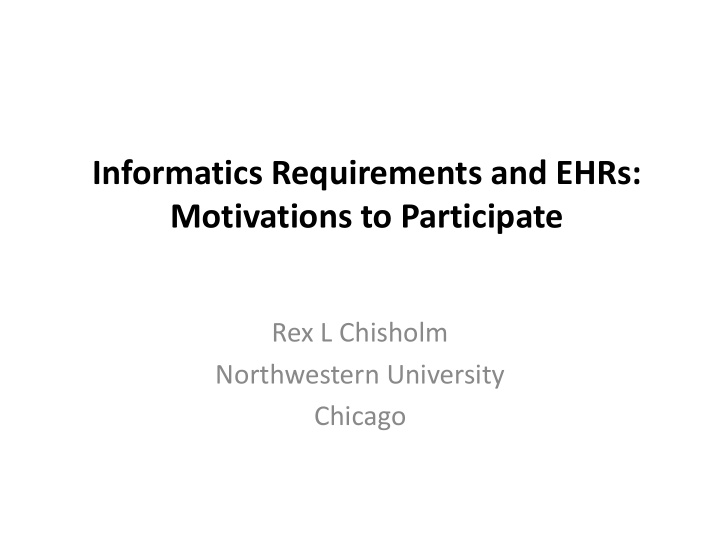



Informatics Requirements and EHRs: Motivations to Participate Rex L Chisholm Northwestern University Chicago
EHRs and Precision Medicine Roles for EHRs in Precision Medicine Initiatives – Facilitating Discovery – Implementation EHRs are more than provider entered data • Means to collect patient/participant entered information • Access to research result (My Research Chart) EHR extracted information alone will not be sufficient to achieve our goals
Coordinating Center An NHGRI funded consortium
Cohort of Cohorts Strengths • Priority could be given to on ‐ going data collection linked to EHR • Potential for active engagement • Wide scientific engagement Possible weakness • Potential for limited data elements • Status of consent
Business case: Cohort of Cohorts Potential Barriers • Loss of control of data • Sustainability issues • Reduced engagement by investigators who established Incentives • Expanded data to add value to the original goals of the cohort • More statistical power • Expanded recruitment
Clinical Providers able to provide extracts of EHR data Strengths • Extensive and varied data • “Unselected” Real ‐ world data • Can provide granular consenting mechanism • Develop learning healthcare systems Weaknesses • Sparse Matrix • Requires additional consenting
Business case: Clinical Providers Potential Barriers • Loss of control of data • Liability concerns • Commitment of clinical IT units Incentives • Return of data may benefit clinical care • Potential marketing value • Expanded recruitment • May align with new payment models
Volunteers utilizing "blue button" technology Strengths • Engaged participants • Clear mandate from community • Solves the “ownership” problem Weaknesses • Technology not yet mature • Requires tool and method development to enable full utility
Business case: Blue Button Volunteers Potential Barriers • Need to develop strong educational programs • Uneven levels of participation • Study fatigue • Complexity of data interpretation Incentives • Return of data may benefit clinical care • Improving their future health of family • Engagement as a full partner
Centralized vs Federated Organization Centralized: • Efficient • Potentially Unwieldy • Need to develop “credit” mechanisms Federated: • Maximizes broad participation • Engages local experts with domain knowledge • Reduces concern of loss of data control
What Next?? • EHRs and the data they hold represent a critically important resource for this effort— and someone else is paying for that resource and collecting the data • Explicitly consider incentives and disincentives to participate for all stakeholder groups in design—it will make a huge difference • Incorporate planning for Implementation in the design considerations from the beginning
Recommend
More recommend